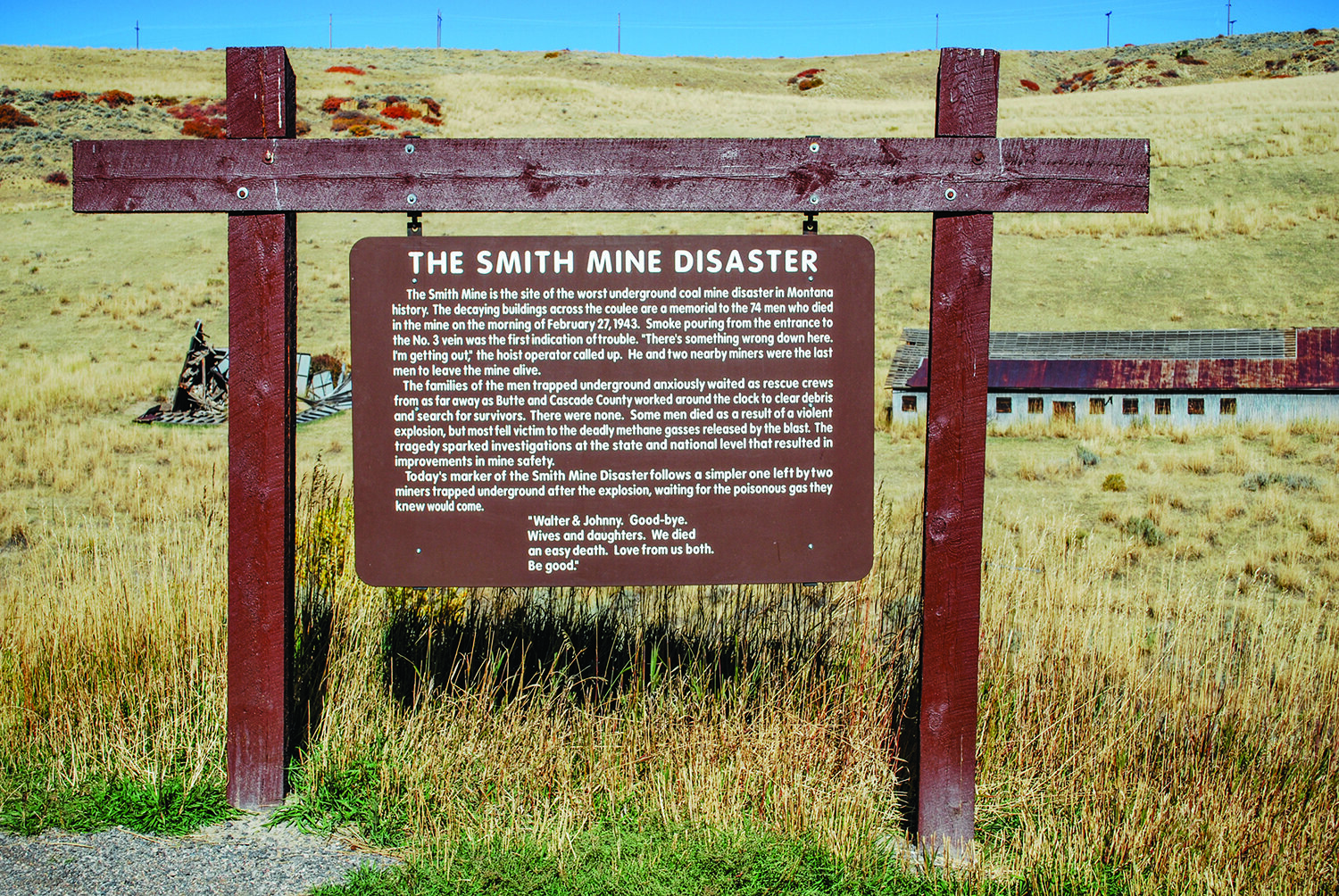Dusting Off History
80 Years Later - Remembering The Smith Mine Disaster
Bearcreek, MT
Photography by Stu Hoefle
Engraved on a black marble monolith in the basement of the Red Lodge Historical Museum are 74 names of deceased men bonded in a companionship of tragedy on a single day in February 1943. Listed are individuals, ages 19 to 72, from far corners of the globe who all found themselves together in the subterranean passages miles beneath the rolling foothills of Bearcreek, Montana. The names on the mute monument reflect the diversity of the lost men – origins including Finnish, Welsh, Scandanavian, Irish, Italian and others – yet all Americans making up an international community that encompassed the workforce of the Smith Mine that tragic day.
The memorial is included in an expansive exhibit which relates the history of coal mining in Carbon County and tells the story of the Smith Mine disaster on February 27, 1943. Of the 77 miners working far beneath the earth that dark day, only three escaped. That February morning, miners reported for their work shift as normal, changing clothes, and picking up helmets. Lunch pails in hand, they moved onto the conveyance descending deep beneath the hills, not knowing it would be the last time many of them would see blue sky or breathe fresh air.
Only an hour into the shift, disaster launched its carnage. Methane gas within the mine had been a long-standing problem, yet only minimal, and mostly ineffective, procedures were in place to identify dangerous levels in the tunnels which ran for nearly 3 miles underground. A mine inspector had visited the site earlier and noted the lack of crushed rock covering piles of highly flammable coal dust. “Rock dust” would have reduced the potential for explosion within the tunnels. Many miners used carbide lamps on their helmets which shed light via an open flame. The inspector had noted this in his report, but company officials failed to take steps to obtain battery powered lamps which were safer when methane gas was concentrated.
It remains unknown exactly what caused the explosion and fire which quickly engulfed the mine tunnels and sealed off any escape for the men. It’s possible a carbide lamp on a miner’s helmet met a pocket of deadly methane gas, touching off the initial explosion and creating a firestorm of explosive coal dust. Carbon monoxide rapidly spread throughout the subterranean corridors, giving miners only moments to escape before the gas rendered them unconscious and they succumbed to death.
Word of trouble at the mine quickly spread through the Washoe and Bearcreek communities and family members rushed to the mine headquarters to seek information about husbands, fathers, and brothers. There was virtually no safety rescue equipment available, and first responders were only able to travel a short distance into the tunnels before having to retreat from the noxious gas and smoke. Calls went out to other area mines for workers to come help with rescue efforts at the Smith Mine. Most responded but were only able to spend limited time in the contaminated mine before seeking fresh air above ground.
The news traveled beyond Carbon County and within a day, experienced underground men from Butte and other Montana mines were on the scene along with state officials, Red Cross volunteers, and law enforcement officers. Emergency sites were set up in Red Lodge to nurse rescue workers who were overcome with fumes inside the mine while searching for victims. Portable kitchens worked around the clock to serve hundreds of volunteers helping with the response. Despite great rescue efforts, the poison fumes and burned seams prevented the recovery of all 74 bodies until March 6, a full week after the tragedy.
Coal mining was an important industry in Carbon County, starting around 1889 and lasting for nearly 60 years before declining and finally coming to a halt. Beneath the foothills and drainages are still seams of subbituminous coal ranging from 4 to over 30 feet in thickness. The coal quality was good, and the high economic return attracted several different mines, along with investors from financial centers in the eastern United States. The Smith Mine, producing over 500,000 tons of coal per year, was part of a Boston investment firm and was owned by the Montana Coal and Iron Company, which operated from 1889 to 1967, although coal mining slowly declined after World War II.
The Carbon County Historical Museum in Red Lodge has created a remarkable display of the Smith Mine event in the basement of the museum. Included is a diorama of the mine as it would have appeared in 1943. Information about mining history in Carbon County has been thoughtfully presented to give the visitor a deeper understanding of underground mining in the past. The museum bookstore includes several volumes with detailed history of the Smith Mine as well.
The Smith Mine disaster is considered the worst mining event in Montana history to this day. Dozens of wives and children were left without husbands and fathers. In the years following, granite memorials were placed in the Red Lodge and Bearcreek cemeteries with engraved names of the men who died in the mine. Some of the victims’ families remained in the area and found ways to move on with life, while others left to follow paths in places not associated with coal mining. Now, 80 years later, many relatives have passed yet remaining along the wind-swept foothills near the Washoe location of the mine is a quiet roadside pullout with a historical marker. The abandoned remnants of the mine buildings falling further into decay with each passing year still stand stark against the hillside along Montana Highway 308. It is a lonely spot with only faint echoes of the departed rustling through the prairie grass and among the iron skeletons surrounding the mine shaft.









